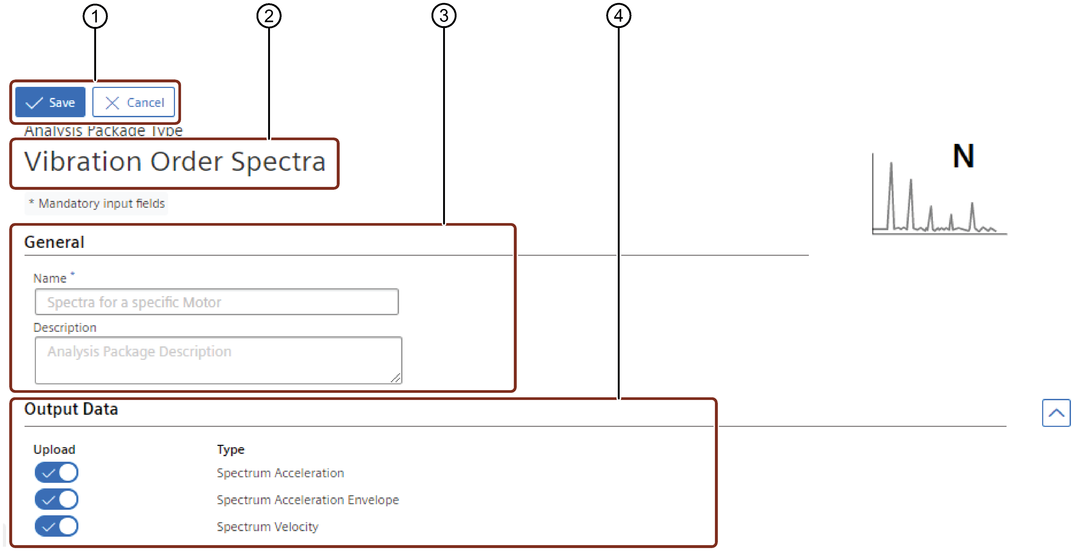Analysis package “Vibration Order Spectra”¶
The analysis package "Vibration Order Spectra" analyzes vibration signals by calculating selected spectral quantities (Fast Fourier Transformation) such as frequency-based acceleration, acceleration envelope, and velocity spectra. These quantities can be used to evaluate the spectral composition of the given input signal and allow early detection of the mechanical fault of rotating equipment. Besides the vibration data, the speed data is also required as an input, which is used for the order tracking technique, whereby the nonstationary vibration data is resampled to an equal angle-interval at a rate proportional to the shaft rotating speed. As a result, the order Spectrum is calculated. The Order Spectrum can be used for time-varying rotating speed cases where the speed variation may cause smearing of the frequencies in a Frequency Spectrum, for example, during a startup or shutdown process of rotating machinery.

① Save or cancel changes
② Package name
③ Input fields for name and description of the analysis
④ Available calculations
Following default parameters are used for the calculation.
Parameters of "Vibration Order Spectra"¶
| Area | Parameter | Description |
|---|---|---|
| General | Analysis Package Name | Add an individual name for your analysis package. |
| Description | Add an individual description (optional). | |
| Calculations | Spectrum Acceleration | In the case of machines and gears running on roller bearings, the calculation of the vibration acceleration a(t) spectrum may be informative regarding the state of the bearings or toothing. In general, it is suitable to get indications about potential error sources within the higher frequency range (>1000 Hz). The following default parameter are used for the calculation: - Max Order: 128 - NoP (Number of Points): 16384 - Overlap: 0.6 - Min Speed: 15 Hz (900 rpm) - NoSpm for average: 5 - Bandpass Filter: 10 - 10000 Hz |
| Spectrum Acceleration Envelope | Envelope curve analyses are frequently used as a demodulation method in the investigation of periodic, shock type vibration, such as may be encountered with damaged roller bearings or gears. These extremely short-lived, rapidly decaying shocks are not susceptible to direct frequency analysis to determine their periodicity. For this to be done, the envelope curve which envelopes the time function must be determined. With the resulting spectrum of the envelope, it is possible to determine frequencies of periodic, shock type vibration and their potential root cause. The following default parameter are used for the calculation: - Max Order: 128 - NoP: 16384 - Overlap: 0.6 - Min Speed: 15 Hz (900 rpm) - NoSpm for average: 5 - Lowpass Filter (Hz): 1.500 - Bandpass Filter: 10 - 10000 Hz | |
| Spectrum Velocity | Vibration velocity v(t) is the decisive measured quantity specified in all standards for evaluating vibration in the stationary components of machines with rotating masses. The resulting calculated spectrum of this signal gives indications about potential error sources within the lower frequency range (<1000 Hz). The following default parameter are used for the calculation: - Max Order: 64 - NoP: 8192 - Overlap: 0.6 - Min Speed: 15 Hz (900 rpm) - NoSpm for average: 5 - Bandpass Filter: 10 - 1000 Hz |
Note
A fully configured monitoring of the analysis packages "Vibration Characteristic Values" and "Vibration Order Spectra" with a Continuous Calculation Mode (Trigger Rule) and all channels of one SM1281 can exceed the CPU performance of the MindConnect Nano. Also, in other scenarios dependent on tasks running in parallel on the MindConnect Nano, CPU load can get too high. The recommendation is to use only two fully configured "Vibration Frequency Spectra" Analysis packages in parallel.